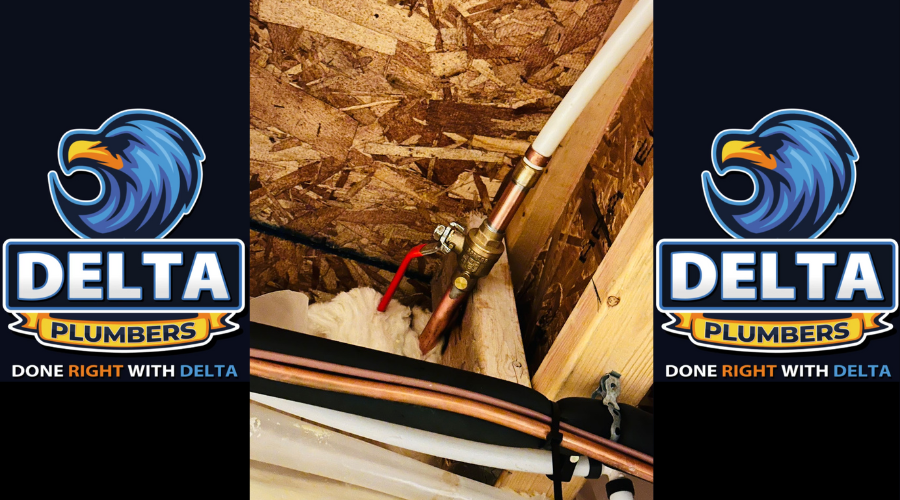Spring in Ontario brings warmer weather, longer days, and a perfect opportunity to address plumbing issues that may have been overlooked during the colder months. After a harsh winter, pipes, water heaters, and outdoor faucets often experience stress, and now is the ideal time for homeowners to perform plumbing maintenance to ensure a hassle-free year. Spring plumbing maintenance helps you identify issues early, preventing costly repairs down the line.
In this guide, we’ll cover essential spring plumbing maintenance tips for Ontario homeowners so you can keep your plumbing system in top shape. Let’s dive into the details of each critical area of your home’s plumbing system that deserves attention this spring.

Picture Source – Delta Plumbers
Inspect Pipes for Freezing Damage
Ontario winters are notorious for freezing temperatures, and if your pipes weren’t properly insulated, they may have been at risk of freezing during the colder months. When water freezes inside pipes, it expands, leading to cracked or burst pipes. This can cause significant water damage and require costly repairs.
Why this matters: After the spring thaw, it’s crucial to check for any damage that may have been caused by freezing temperatures. Pipes that were exposed to the cold can leak or even burst, leading to serious issues in your home. Frozen pipes often go unnoticed until it’s too late, so regular checks are important.
What to check for:
- Outdoor Faucets: Start with outdoor faucets, which are the most vulnerable to freezing. Ensure they are not cracked or damaged. If you see any leaks or damage, replace the faucet immediately. It’s best to shut off the water to outdoor faucets in the fall, but checking them in the spring ensures you’ll catch any lingering issues.
- Basement Pipes: If you have pipes running along exterior walls or in the basement, check for signs of freezing damage. These pipes are especially prone to freezing in winter and may require additional insulation. Look for cracks, leaks, or bulging pipes. If you notice any damage, it’s crucial to repair it before it worsens.
- Exposed Pipes: Inspect any exposed pipes under your sinks or in your attic. These areas should be insulated to prevent freezing during winter. If you didn’t insulate these areas before winter, make it a priority to do so now.
Action steps:
- If you find any damaged or cracked pipes, call a plumber for repairs or replacement.
- Insulate any exposed pipes in unheated areas like the attic, basement, or garage to prevent future freezing.
Also Read: The Rising Cost of Plumbing Repairs in 2025

Picture Source – Delta Plumbers
Clean and Maintain Your Sump Pump
Spring often brings heavy rains to Ontario, and a properly functioning sump pump is essential for preventing basement flooding. After months of sitting unused during the winter, it’s essential to give your sump pump some attention.
Why this matters: Sump pumps are your first line of defense against water damage in the basement, especially after spring rains. If your sump pump isn’t working correctly, you risk flooding, which can damage your foundation, walls, and belongings. Over time, dirt and debris can accumulate in the pump and its discharge pipe, reducing efficiency.
How to maintain your sump pump:
- Test the Pump: Pour water into the sump pit to activate the pump. Check if the pump is operating smoothly and pumping the water out of the pit.
- Clean the Pump: Turn off the power and remove any debris or dirt from the pump. Cleaning the pump ensures it runs efficiently during the rainy season.
- Check the Discharge Pipe: Ensure the discharge pipe is free from clogs and debris. Blocked discharge pipes can cause water to back up into the sump pit, preventing the pump from draining properly.
- Inspect the Check Valve: A check valve prevents water from flowing back into the sump pit after it’s been pumped out. Ensure the valve is working correctly and isn’t clogged.
Additional tips:
- If you have a battery-powered backup system, check the battery to ensure it’s in good condition.
- Consider installing a water alarm that alerts you when the water level in the pit is too high, indicating that the pump may be failing.
Also Read: Smart Plumbing Solutions

Picture Source – Delta Plumbers
Check Water Heater Efficiency
Your water heater works hard during the cold winter months to provide hot water for showers, cleaning, and heating your home. After months of continuous use, it’s a good idea to inspect your water heater to ensure it’s running efficiently.
Why this matters: A well-maintained water heater will operate more efficiently, saving energy and extending its lifespan. Neglecting your water heater can lead to reduced hot water availability or even complete system failure.
How to maintain your water heater:
- Flush the Tank: Over time, sediment and minerals from hard water can build up inside the tank. This sediment buildup can reduce the efficiency of the water heater and cause it to overheat. Flushing the tank removes sediment, allowing the water heater to operate more efficiently. To flush the tank, turn off the power supply or gas valve, connect a hose to the drain valve, and direct the hose to a drain. Open the valve to flush out the sediment.
- Check the Temperature: Ensure the thermostat is set to the recommended temperature of 120°F (49°C). This temperature is both energy-efficient and safe for household use.
- Inspect for Leaks: Look around the tank and pipes for any visible signs of leaks. Leaking water around your water heater can indicate corrosion or other damage that needs to be addressed.
- Test the Pressure Relief Valve: The pressure relief valve is an important safety feature of your water heater. It releases excess pressure to prevent the tank from bursting. To test it, lift the valve’s lever and allow a small amount of water to flow out. If no water flows, the valve may need to be replaced.
Action steps:
- If you find any signs of leaks or significant damage, call a professional plumber for repairs or replacement.
- Regularly flush your water heater to maintain its efficiency and prolong its lifespan.
Also Read: Common Causes of Sudden Water Leaks & How to Fix Them

Picture Source – Delta Plumbers
Clear Clogged Drains and Inspect for Leaks
During the winter, it’s easy to forget about the drains in your home. However, as spring approaches, you may notice slower draining or unpleasant smells from your sink, shower, or bathtub. Clogs can form due to hair, grease, food particles, or soap buildup.
Why this matters: Clogged drains can lead to slow water flow, standing water, or even backups into your home. Clogs may not always be visible but can cause long-term damage if left unaddressed.
How to maintain your drains:
- Use Drain Covers: Install drain covers to catch hair, soap, and debris before they enter the pipes. This simple step can prevent many clogs.
- DIY Drain Cleaning: Use a mixture of baking soda and vinegar to clear minor clogs. Pour a half cup of baking soda down the drain, followed by a half cup of vinegar. Let it sit for 15 minutes, then rinse with hot water.
- Use a Plunger or Plumbing Snake: For more stubborn clogs, use a plunger or plumbing snake to clear the blockage. Avoid using chemical drain cleaners, which can damage pipes over time.
- Check for Leaks: Leaky pipes under sinks can lead to water damage and increased water bills. Check under your sinks for any signs of moisture. Tighten any loose connections and replace any old washers or seals.
When to Call a Professional:
If you experience persistent clogs or slow drainage, it’s time to call a plumber. They can perform a thorough inspection and clear out any deep blockages.
Also Read: Sewer Line Problems in Toronto: Causes & Solutions

Picture Source – Delta Plumbers
Test Water Pressure and Address Issues
Spring plumbing maintenance is the perfect time to check your water pressure. Both high and low water pressure can indicate underlying plumbing issues. High water pressure can cause wear on your pipes, while low water pressure may indicate clogs or issues with the main water line.
Why this matters: If your water pressure isn’t at the correct level, it can cause a range of plumbing issues. Low water pressure may make everyday tasks like showering or washing dishes difficult, while high pressure can damage pipes and fixtures over time.
How to check water pressure:
- Use a Water Pressure Gauge: To check the pressure in your home, attach a water pressure gauge to an outdoor faucet. The pressure should fall between 40 and 60 PSI. Anything higher or lower than this range may require adjustments.
- Adjust Pressure Regulator: If your home has a pressure regulator, it may need adjustment. A plumber can recalibrate it to ensure your water pressure is within the optimal range.
- Address High Pressure: If you have high water pressure, it can strain your plumbing and lead to leaks or burst pipes. You may need to install or adjust a pressure-reducing valve.
Action steps:
- Call a plumber if you notice significant water pressure issues that cannot be resolved with basic adjustments.
Also Read: Why Ontario Homes Need Special Plumbing Care

Picture Source – Delta Plumbers
Examine Outdoor Faucets and Hose Bibs
Outdoor faucets are commonly overlooked during the colder months, but they’re vulnerable to freezing temperatures in Ontario. If your outdoor faucets aren’t properly winterized, they can crack or leak when you begin using them in the spring.
Why this matters: A damaged outdoor faucet can lead to water waste and higher utility bills. Additionally, a frozen faucet can lead to pipe damage if not addressed quickly.
How to maintain your outdoor faucets:
- Inspect Faucets: Turn on each outdoor faucet and check for leaks. If the faucet is cracked or leaking, it will need to be replaced.
- Check Garden Hoses: Remove any garden hoses attached to outdoor faucets. Inspect the hoses for damage and replace any worn or cracked hoses. Disconnecting hoses before winter prevents damage to faucets during freezing weather.
- Install Faucet Covers: Consider installing faucet covers to protect outdoor faucets during the winter. These covers prevent freezing and cracking.
Also Read: The History of Canadian Plumbing: From Ancient Rome to Modern Homes

Picture Source – Delta Plumbers
Inspecting Sewer Lines for Blockages
Many homeowners neglect their sewer lines until something goes wrong, but regular maintenance is key to avoiding plumbing disasters. Tree roots, grease, and debris can clog your sewer lines over time, leading to slow drainage, unpleasant odors, or even sewage backups.
Why this matters: A clogged or damaged sewer line can cause severe plumbing issues, including backups that may lead to extensive damage and costly repairs.
How to maintain your sewer line:
- Signs of Blockages: Slow drains, gurgling sounds, or foul odors near drains are signs of a potential sewer line issue. If you notice any of these symptoms, it’s time to inspect your sewer line.
- Professional Inspection: Schedule a professional inspection using a camera to inspect the condition of your sewer line. A plumber can identify any blockages or tree root intrusions and recommend appropriate treatments.
- Hydro-jetting: Hydro-jetting is an effective method for cleaning out tree roots and debris from your sewer line. It uses high-pressure water to clear obstructions without damaging pipes.
Action steps:
If you suspect a sewer line blockage, contact a plumber immediately. Regular inspections and maintenance can prevent major problems.
Conclusion –
Spring plumbing maintenance is a critical task for homeowners in Ontario. By performing these essential checks and maintenance tasks, you can avoid costly repairs and ensure that your plumbing system is functioning at its best. Take the time to inspect your pipes, sump pump, water heater, drains, and outdoor faucets—your future self will thank you for the proactive steps you take now.
If you encounter any issues or need professional assistance, don’t hesitate to call a trusted plumber. Regular maintenance ensures that your plumbing system remains reliable, efficient, and ready for the challenges of each season. Stay ahead of potential problems and enjoy peace of mind throughout the year!









